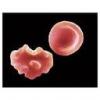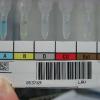Reputation Activity
-
 tcoyle got a reaction from David Saikin in saline and diluent
tcoyle got a reaction from David Saikin in saline and diluent
And then a comprehensive validation to show that it would work in all situations.
Best to stick with what the manufacturer requires in their directions.
-
 tcoyle reacted to David Saikin in TRM.30700
tcoyle reacted to David Saikin in TRM.30700
As an inspector for >20 yrs: unless you are making packed cells, modified WB, splitting unit, drawing donors - I would mark this question as NA.
If, as noted above, you had a thawed plasma with a clot - you would note that in your inspection prior to release and deal w it appropriately.
-
 tcoyle reacted to David Saikin in Transport or Storage?
tcoyle reacted to David Saikin in Transport or Storage?
This was a hot topic about 2 yrs ago. The FDA came out and said that storage in blood boxes/coolers is considered storage NOT transport. AABB/CAP might be mollified, I don't think the feds will think twice about a 483. Unless you are putting the product in a BB refrig.
Check out posts from Feb, 2016
-
 tcoyle reacted to AMcCord in At my hospital we manually enter Type and Screen results....
tcoyle reacted to AMcCord in At my hospital we manually enter Type and Screen results....
CAP requires verification of all manual entries - this is in the All Common checklist. Every one of those errors should be documented with investigation and resolution - this is also something that a CAP inspection should be looking at with every inspection. Is the rest of the lab having as many problems???
-
 tcoyle got a reaction from Malcolm Needs in At my hospital we manually enter Type and Screen results....
tcoyle got a reaction from Malcolm Needs in At my hospital we manually enter Type and Screen results....
Hello paddleking: I'm curious if you are AABB accredited or inspected by CAP or ??? Does your hospital have a patient safety reporting program? Does your laboratory have a QA unit and/or event management system? Seems like there are many processes out of control...
-
 tcoyle reacted to Mrasmus1 in Specimen / Product outdate
tcoyle reacted to Mrasmus1 in Specimen / Product outdate
We would issue with 15 minutes left on the type and screen. And, per the AABB's 2010 Ask the FDA and CLIA Transcript:
Question 34: The Circular of Information, for the Use of Human Blood and Blood Components, in the Instructions for Use section, item number 13 states: "Transfusion should be started before component expiration and (be) completed within 4 hours." What is the FDA's interpretation with regard to this instruction? For example, is it acceptable to start a component at 23:45 on the expiration date and allow the unit to be transfused for 4 hours (until 03:45 the next morning)?
MS. CIARALDI: Our regulations in 606.122 state that administration should start within four hours of entering the product. To us, this means that transfusion must be started within the shelf life of the unit. The length of time to hang a unit, specified in the Circular of Information, is four hours. We are aware that this may sometimes result in the transfusion ending after the unit has expired; however, we do not object to this practice.
-
 tcoyle got a reaction from tbostock in Training new employees
tcoyle got a reaction from tbostock in Training new employees
One way to document the persons non compliance is through event management and training.
Part of the training should require documented competency before they start submitting patient test results on their own and direct observation should be a part of that. If this person cannot pass their competency then you have documented evidence.
If you know this person is not following SOP, you should be able to document such in your event management system. Hopefully your SOPs also out line that concurrent documentation is required.
Based on the Fair and Just Culture of event management, this sounds like the Reckless behavior where the person is making these conscious choices and disregarding the risk involved. This type of behavior should not be ignored and requires corrective action.
Patient Safety and the "Just Culture." A Primer for Health Care Executives Prepared by David Marx, JD
-
 tcoyle got a reaction from Baby Banker in Training new employees
tcoyle got a reaction from Baby Banker in Training new employees
One way to document the persons non compliance is through event management and training.
Part of the training should require documented competency before they start submitting patient test results on their own and direct observation should be a part of that. If this person cannot pass their competency then you have documented evidence.
If you know this person is not following SOP, you should be able to document such in your event management system. Hopefully your SOPs also out line that concurrent documentation is required.
Based on the Fair and Just Culture of event management, this sounds like the Reckless behavior where the person is making these conscious choices and disregarding the risk involved. This type of behavior should not be ignored and requires corrective action.
Patient Safety and the "Just Culture." A Primer for Health Care Executives Prepared by David Marx, JD
-
 tcoyle got a reaction from BldBnker in Stop transfusion if crossmatch expires after issue but before whole unit in?
tcoyle got a reaction from BldBnker in Stop transfusion if crossmatch expires after issue but before whole unit in?
Can you imagine what a nightmare of logistics it would be if we had to be concerned about that? As long as you issued your product on that good specimen before it expired, you are fine. We have the same practice. Our day of draw is day 0 and then our specimens expire at midnight on day 3. We could issue products on that specimen up to the minute before it expired.
-
 tcoyle got a reaction from Dansket in Stop transfusion if crossmatch expires after issue but before whole unit in?
tcoyle got a reaction from Dansket in Stop transfusion if crossmatch expires after issue but before whole unit in?
Can you imagine what a nightmare of logistics it would be if we had to be concerned about that? As long as you issued your product on that good specimen before it expired, you are fine. We have the same practice. Our day of draw is day 0 and then our specimens expire at midnight on day 3. We could issue products on that specimen up to the minute before it expired.
-
 tcoyle reacted to JLF in Detecting ABO incompatibility with Validated Computer System
tcoyle reacted to JLF in Detecting ABO incompatibility with Validated Computer System
I asked AABB to clarify and received this response:
Please refer to AABB Blood Banks and Transfusion Services Standard 5.16 Crossmatch section (30th edition).
Standard 5.16.1 states… “The crossmatch shall use methods that demonstrate ABO incompatibility and clinically significant antibodies to red cell antigens and shall include an antiglobulin test as described in Standard 5.14.3.”
Standard 5.16.1.1 states “If no clinically significant antibodies were detected in tests performed in Standard 5.14.3 and there is no record of previous detection of such antibodies, at a minimum, detection of ABO incompatibility shall be performed.”
Standard 5.16.2 states… “If a computer system is used as a method to detect ABO incompatibility, the following requirements shall be met:….” See standards 5.16.2.1 – 5.16.2.5.
In summary, if you are doing an extended/Coombs crossmatch, you also need a method to demonstrate ABO incompatibility. This is most often done by an immediate spin crossmatch. Check your manufacturer’s instructions (Gel Cards, PeG, LISS, etc) to see if these reagents state that they also detect ABO incompatibility. Most of the time they do not, which is why an immediate crossmatch is performed along with the antiglobulin test.
An electronic crossmatch can be done in lieu of the immediate spin phase if the requirements from Standards 5.16.2.1 – 5.16.2.5 have been met. Keep in mind that an electronic crossmatch can only detect ABO incompatibilities and does not include an antiglobulin test. So if the patient needs an extended/Coombs crossmatch, how is the ABO incompatibility being demonstrated? Is the LIS validated to combine an electronic crossmatch with an extended/Coombs crossmatch (this is usually no), does the antiglobulin test detect ABO incompatibility (this is usually no), or do you need to do an immediate spin crossmatch?
-
 tcoyle reacted to SMILLER in Competency on Couriers
tcoyle reacted to SMILLER in Competency on Couriers
Did they happen to cite a specific standard? Just curious.
Thanks, Scott
-
 tcoyle reacted to sgoertzen in Meditech Aliquot adding to DIN number
tcoyle reacted to sgoertzen in Meditech Aliquot adding to DIN number
This is the way Meditech documents the splitting of products. Now with ISBT, the product code does not change when you split, so this is how the computer differentiates one split from another made from the same product. The split number (A, B, Ba, whatever) needs to print on the tag so you can tag the product properly and the blood bank and bedside staff know which split is being issued and transfused. I've had Meditech 27 years, we're a pediatric hospital so we make tons of aliquots, and no inspector (CAP, AABB, FDA, JC) has ever had a problem with this. Your CAP inspector should not cite you for something they don't understand. The previous post is correct - adding an A or B to the DIN when splitting has nothing to do with a closed or open system. I would challenge that citation.
-
 tcoyle reacted to BankerGirl in Meditech Aliquot adding to DIN number
tcoyle reacted to BankerGirl in Meditech Aliquot adding to DIN number
Was the inspector referring to the ISBT label or the IT form? If it is the IT form, look at KB article 27704. This will change the number that prints on the card so it matches the ISBT format. I think that may be what was troubling the inspector, although what he said doesn't make sense. I'm just guessing that he heard this previously and didn't remember the correct reason that it troubled him. If that is not the case, then I don't have any suggestions other than to plead your case with CAP after the citation is confirmed.
-
 tcoyle got a reaction from Malcolm Needs in Meditech Aliquot adding to DIN number
tcoyle got a reaction from Malcolm Needs in Meditech Aliquot adding to DIN number
If it's an open system unit, according to the ICCBBA language you should have OPEN SYSTEM on the label. And, if you have a closed system for your aliquots the expiration date should be the same as your unit that the aliquot was taken from. Did CAP site you for the "A" added or only that the person couldn't tell if it was a closed system aliquot? (which seems odd...) Sorry I can't answer your question about Meditech, but it's strange that it adds something to your label.
-
 tcoyle reacted to Marianne in FDA reportable Question
tcoyle reacted to Marianne in FDA reportable Question
Also, if you report and it is not a reportable issue, they will tell you that and it is removed. So always better to err on the side of caution and have them reject, rather than miss reporting.
-
 tcoyle reacted to mollyredone in Computer Crossmatches and Revised CAP regs
tcoyle reacted to mollyredone in Computer Crossmatches and Revised CAP regs
The way I read this, is "if discrepancies exist". Not if discrepancies existed (in the past). So if you have a discrepancy and resolve it, it does not exist anymore. So if you can't resolve the discrepancy currently with other techniques, a serologic crossmatch would be required, but if you followed through with your procedure to resolve the discrepancy, it is no longer a discrepancy.
-
 tcoyle got a reaction from mpmiola in 4 hours to transfuse
tcoyle got a reaction from mpmiola in 4 hours to transfuse
The Circular of Information for the use of Human Blood and Blood Components has information regarding transfusion within 4 hours. Here is an excerpt: "Transfusion should be started before component expiration and completed within 4 hours." And another, "The initial portion of each unit transfused should be infused cautiously and with sufficient observation to detect onset of acute reactions. Thereafter, the rate of infusion can be more rapid, as tolerated by the patient’s circulatory system. It is undesirable for components that contain red cells to remain at room temperature longer than 4 hours. If the anticipated infusion rate must be so slow that the entire unit cannot be infused within 4 hours, it is appropriate to order smaller aliquots for transfusion."
-
 tcoyle reacted to David Saikin in Moved Again
tcoyle reacted to David Saikin in Moved Again
I have retired from active clinical laboratory - for what it is worth.
-
 tcoyle got a reaction from Cliff in 4 hours to transfuse
tcoyle got a reaction from Cliff in 4 hours to transfuse
The Circular of Information for the use of Human Blood and Blood Components has information regarding transfusion within 4 hours. Here is an excerpt: "Transfusion should be started before component expiration and completed within 4 hours." And another, "The initial portion of each unit transfused should be infused cautiously and with sufficient observation to detect onset of acute reactions. Thereafter, the rate of infusion can be more rapid, as tolerated by the patient’s circulatory system. It is undesirable for components that contain red cells to remain at room temperature longer than 4 hours. If the anticipated infusion rate must be so slow that the entire unit cannot be infused within 4 hours, it is appropriate to order smaller aliquots for transfusion."
-
 tcoyle got a reaction from David Saikin in BB Validation/New Server
tcoyle got a reaction from David Saikin in BB Validation/New Server
We just moved to a new server for our donor system and we did a short validation to ensure that we could enter and receive all information end to end. That would include our connections to our donor questionnaire program, registration, draw information, manufacturing of the unit and exporting the unit to our transfusion system. We also tested our instrument interface that sends donor tests and the interface that we receive our tests that we send out for donor testing. It might seem like a lot to some, but when they are moving your whole application to a new piece of hardware, it would be prudent to ensure they did it correctly. We have a validation environment that they did the changes to first so that we could do our validation, (from which we did find some problems) then we performed a smoke test in the production side after the move as well.
Considering that FDA states that you should validate your system...using the same software, hardware etc...I would recommend some type of documented validation.
-
 tcoyle reacted to John C. Staley in 2 cell vs 3 cell screen
tcoyle reacted to John C. Staley in 2 cell vs 3 cell screen
We initially switched to a 3 cell screen because it made the transfusion service medical director more comfortable when we went to the immediate spin crossmatch. That was a long time ago and I don't know if the facility is still using the 3 cell screen or not. I suspect they are since inertia is the most powerful force in the universe which explains why blood bankers find it nearly impossible to change once the course is set. (This of course, was typed with a partial smile!)
-
 tcoyle reacted to kholshoe in Blog - Techs DO Connect to Patients!
tcoyle reacted to kholshoe in Blog - Techs DO Connect to Patients!
Hi everyone,
I would really encourage you to take a moment to read a blog article I wrote regarding a lab scientist's connection to their patients from "behind the scenes". This subject is very near and dear to my heart and I hope others find that it resonates with them as well. Please feel free to share any thoughts below the article in the comments section. Thank you for taking the time to click! And as always, thank you for being an integral part of our healthcare system.
https://www.staffready.com/patient-behind-scenes/
-
 tcoyle reacted to kate murphy in Electronic Crossmatch
tcoyle reacted to kate murphy in Electronic Crossmatch
We were late to the game, 2010. But no reactions due to ABO mismatch.
A few febrile, a few allergic. Nothing the crossmatch would catch.
-
 tcoyle got a reaction from tbostock in Blood Product Check on Nursing Unit
tcoyle got a reaction from tbostock in Blood Product Check on Nursing Unit
Here is the article describing that incident that a colleague shared with us recently. An awful story, but worth reading and recognizing the importance of the checks that are put in place to keep patients safe. http://www.thecomet.net/news/nurse_from_stevenage_given_suspended_sentence_after_using_wrong_type_of_blood_in_transfusion_which_killed_patient_1_4883904






